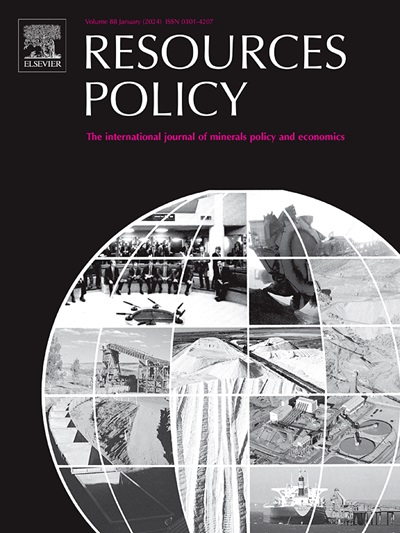Assessment of critical minerals supply chain for the United States in perspective of trade restriction by foreign countries
IF 10.2
2区 经济学
0 ENVIRONMENTAL STUDIES
引用次数: 0
Abstract
In this study, major global producers of the 50 critical minerals designated by the United States government in 2022 were investigated to analyze the supply chain vulnerability to the United States by screening a single foreign country’s role at extraction, processing, and trade. The “freedom in the world” indicator was integrated into these stages to calculate the score of potential risk (Spr), which this study introduced to assess the likelihood of supply chain disruptions. The commodities with high scores of Spr (Tier 1) matched the ones with existing export-controlled critical minerals imposed by China until 2023, which include gallium, germanium, graphite, rare earths, and tungsten. In order of Spr, the remaining minerals were classified into tiers of potential supply risk: Tier 1 (Spr ≥ 50%) indicates high risk (bismuth, magnesium, antimony, and tellurium); Tier 2 (50% > Spr ≥ 32%), moderate risk (indium, vanadium, arsenic, tantalum, and zirconium); and Tier 3 (Spr < 32% with high potential risk if geopolitical conditions change), low to sensitive risk (niobium and platinum). The effectiveness of the approach was further demonstrated by the 2024 export controls implemented by China on antimony, bismuth, and magnesium, which were all classified as Tier 1 prior to the restriction. A short list of critical minerals in this study may be monitored although the current risk is low. The Spr of critical minerals provided an indicator in determining the levels and sources of potential supply risk as well as informing mitigation strategies in the years ahead.
从外国贸易限制的角度对美国关键矿产供应链的评估
在这项研究中,调查了美国政府在2022年指定的50种关键矿物的全球主要生产商,通过筛选单个外国在开采、加工和贸易方面的作用,分析了供应链对美国的脆弱性。“世界自由”指标被整合到这些阶段来计算潜在风险(Spr)的分数,本研究引入Spr来评估供应链中断的可能性。具有高Spr(一级)分数的商品与中国在2023年之前实施的现有出口控制关键矿物相匹配,包括镓、锗、石墨、稀土和钨。根据Spr大小,将剩余矿种划分为潜在供应风险等级:一级(Spr≥50%)为高风险(铋、镁、锑、碲);2级(50% > Spr≥32%),中度风险(铟、钒、砷、钽和锆);第三级(Spr < 32%,如果地缘政治条件发生变化,潜在风险很高),低至敏感风险(铌和铂)。中国在2024年对锑、铋和镁实施的出口管制进一步证明了这种方法的有效性,这些产品在限制之前都被列为一级。虽然目前的风险很低,但这项研究中的一小部分关键矿物质可能会受到监测。关键矿物的战略资源为确定潜在供应风险的水平和来源以及为今后几年的缓解战略提供信息提供了一个指标。
本文章由计算机程序翻译,如有差异,请以英文原文为准。
求助全文
约1分钟内获得全文
求助全文
来源期刊

Resources Policy
ENVIRONMENTAL STUDIES-
CiteScore
13.40
自引率
23.50%
发文量
602
审稿时长
69 days
期刊介绍:
Resources Policy is an international journal focused on the economics and policy aspects of mineral and fossil fuel extraction, production, and utilization. It targets individuals in academia, government, and industry. The journal seeks original research submissions analyzing public policy, economics, social science, geography, and finance in the fields of mining, non-fuel minerals, energy minerals, fossil fuels, and metals. Mineral economics topics covered include mineral market analysis, price analysis, project evaluation, mining and sustainable development, mineral resource rents, resource curse, mineral wealth and corruption, mineral taxation and regulation, strategic minerals and their supply, and the impact of mineral development on local communities and indigenous populations. The journal specifically excludes papers with agriculture, forestry, or fisheries as their primary focus.
 求助内容:
求助内容: 应助结果提醒方式:
应助结果提醒方式:


